Are you doing a deck project?
Modernize can pair you with three to four pros in your area, so you can compare options and save time and money.
With warm weather just around the corner, this is the best time to prepare your outdoor space for months of enjoyment. And if you’re considering building or replacing a deck, you probably have plenty of questions about where to start. Here are five different decking options along with a comparison of the cost, look, life span, and upkeep of each.

Pressure-Treated Lumber Decks
The majority of decks are built with pressure-treated (PT) lumber. You’ll recognize it because the wood is tinted with a greenish hue. The color results from the chemicals used to treat the wood, which is usually southern yellow pine. In the past, those chemicals were chromated copper arsenate, a suspected human carcinogen. But these days, most pressurized wood is treated with either alkaline copper quaternary (ACQ) or copper azole. You can also get wood treated with a nonmetallic preservative.
Upkeep of Pressure-Treated Lumber Decks
Pressure-treated lumber will last many decades, as long as it is routinely maintained—otherwise, the wood will bend or splinter. To keep it in tip-top shape, power wash your pressure-treated deck every couple of years, then treat with a stain or wood preservative.
Cost of Pressure-Treated Lumber Decks
Pressure-treated lumber generally comes in a variety of sizes for planks and posts. A general estimate for a 2 in. x 4 in. x 8 ft #2 Prime Ground Contact Pressure treated lumber plank sells for $4.37 (plus tax).
Composite Lumber Decks
Companies like Trex, TimberTech, and CorrectDeck make planks composed of a mix of wood fibers and recycled plastic. The product won’t rot, splinter, or warp—and it won’t need to be stained. To maintain, scrub with warm, soapy water and spray a little diluted bleach or bleach-based liquid cleanser into corners or hard-to-reach crevices to prevent mildew.
Upkeep of Composite Lumber Decks
Though it’s designed to last for many years, if it does fade over time, the color and original sheen can’t be restored the way a stained wood deck can. Composite board requires less maintenance than wood. It does not need to be sanded, scraped, painted, or stained. Simply wash with warm, soapy water and use a little diluted bleach to tackle mold and mildew if necessary.
Cost of Composite Lumber Decks
Composite board can be thinner than pressure-treated lumber, though it’s also available in a variety of widths and lengths. ArmorGuard 1 in. x 5-1/4 in x 8 ft composite board goes for $17.97, so it’s significantly more expensive than pressure-treated wood.
Plastic Lumber Decks
Lumber made from HDPE or LDPE (think recycled soda bottles and milk jugs) is another option. There are many benefits to it, including very minimal maintenance. The downside to that lack of maintenance is that once the color starts to fade, you will not be able to re-stain it.
Upkeep of Plastic Lumber Decks
It will resist mildew and it won’t rot, which is an important benefit. It can be bought in colors, so it doesn’t require staining or painting. To clean, wash with a garden hose or mop down. To remove stubborn stains, use a mixture of one part bleach to 10 parts water.
Cost of Plastic Lumber Decks
American Plastic Lumber Company says that lumber made from recycled plastic can cost two or three times more than standard wood materials. Indeed, it is often a higher upfront cost than wood.
Find the Right Contractor for Your deck Project
Whether you’re ready to begin your project now or need some expert advice, our network of contractors are here to help. With a few simple questions, we’ll find the best local professionals for you
However, they claim that, long-term, plastic lumber ends up being cheaper due to less expensive maintenance costs and no need to replace rotting wood. Many plastic lumber products are warrantied against mold, termites, and fungal decay and will not split or splinter for 50 years.
Redwood and Western Red Cedar Decks
Planks made from both these trees are aesthetically beautiful and naturally resistant to rot, decay, and insect infestations. They’re also lighter to work with than pressure treated wood.
One caveat when buying redwood or western red cedar is to be sure to purchase products that come from sustainably managed forests, rather than old-growth forests that have been alive for hundreds of years or longer. Look for certification from the Forest Stewardship Council to verify that the planks were grown and harvested to minimize environmental damage.
Upkeep of Redwood and Cedar Decks
They last longer if they’re power washed occasionally and treated with a light or clear stain every few years. Of course, they can also be stained a darker color depending on your preferred style.
Cost of Redwood and Cedar Decks
As for price, both redwood and western red cedar are cheaper in the western U.S.—where they’re native—than in the east. That said, a 4-pack of 2 in x 4 in x 8 ft plank of “construction common” redwood lumber sells for $50.71, which makes its per-plank price more expensive than pressure treated wood, but less expensive than plastic or composite lumber.
Tropical Hardwood Decks
Tropical hardwoods like tigerwood, ipe, merbau, and abaco come from Africa, South America, Malaysia, and the Philippines. They are extremely hard and rot-resistant, and also somewhat rare, which makes it at least as durable as redwood and western red cedar, but also more expensive.
Upkeep of Tropical Hardwood Decks
There is a significant downside to building a deck using tropical hardwoods. Historically, these trees have been harvested from endangered rainforests. Cutting them down has often been done by clear-cutting large swaths of land that destroy the rainforest ecosystem, including the birds and other wildlife that live there.
Cost of Tropical Hardwood Decks
Another downside to hardwoods is their higher price. A case of 3/4 in. Thickness x 4-3/4 in. Width x random length planks that covers 18.70 sq. feet runs $98.92 per case.
The Forest Stewardship Council is working with local producers to create programs that help ensure that tropical hardwoods are harvested sustainably. Nevertheless, given that many other decking options exist, it’s probably more sustainable to choose a material other than tropical hardwood when you decide to build your deck.
Find the Right Contractor for Your deck Project
Whether you’re ready to begin your project now or need some expert advice, our network of contractors are here to help. With a few simple questions, we’ll find the best local professionals for you
Reviews from Real Homeowners
Welcome to Homeowner Resources! We are the Modernize blog. Modernize pairs more than 3 million homeowners a year with pre-vetted contractors in their area. This blog started because we believe homeowners should know everything about their homes, from how their HVAC works to which front door colors they might love. On Homeowner Resources, you can find information on every part of your home, right down to how you can negotiate with contractors to get the best price. Here's more about the blog.
Need a contractor? Learn more about how Modernize finds the right pro for you.



